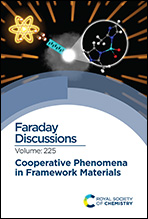Identifying the liquid and glassy states of coordination polymers and metal–organic frameworks†
Abstract
The field of metal–organic frameworks (MOFs) is still heavily focused upon crystalline materials. However, solid–liquid transitions in both MOFs and their parent coordination polymer family are now receiving increasing attention due to the largely unknown properties of both the liquid phase and the glasses that may be formed upon melt-quenching. Here, we argue that the commonly reported concept of ‘thermal stability’ in the hybrid materials field is insufficient. We present several case studies of the use of differential scanning calorimetry alongside thermogravimetric analysis to prove, or disprove, the cooperative phenomena of melting in several MOF families.

- This article is part of the themed collection: Cooperative phenomena in framework materials


 Please wait while we load your content...
Please wait while we load your content...